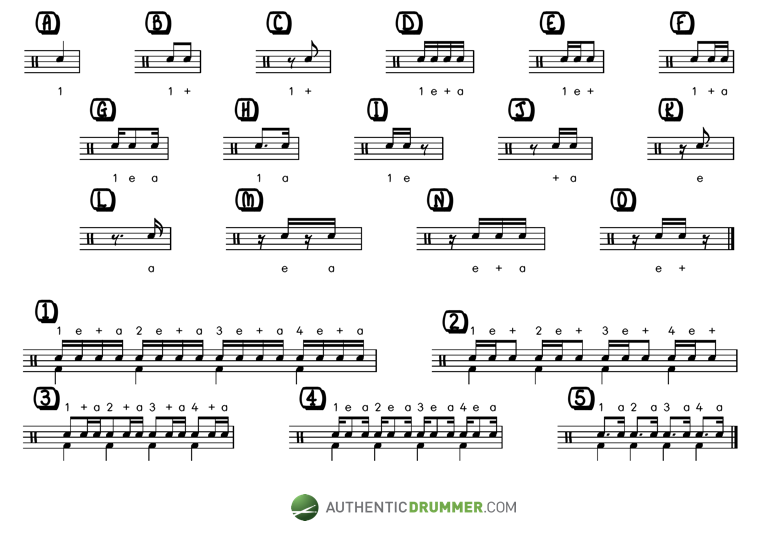
I teach a lot of students and as a rule, reading rhythm is always one of the least loved aspects of playing drums. This is usually because the person claiming this doesn’t know how to read rhythm. It’s like me saying that learning Japanese is hard. Of course it is if I have no idea. So let’s clear up a couple of things and look at some parts of rhythm that changed my way of thinking when I learned to read rhythm.
We’re only going to deal with one beat and some of the subdivisions that fit into that one beat. I’ve found that once you understand that all those notes can split into beats the bars start to make sense. At figures A and B, we have a quarter note (in a bar of four beats, this takes up a quarter) and two 8th notes (a bar of four beats splits into eights). This is a simple subdivision of one beat. Fig. C is our first variation by taking away the first note. Even using just these three rhythms, you can write some interesting bars of music. Each figure counts as one beat. If you have four beats available you can repeat one. You get the idea.
From here it gets a little more interesting. Fig. D shows a group of four 16th notes (a bar of four beats splits into 16). Knowing the combinations you can make with these four notes gives you so much more confidence when it comes to reading them. All we’re going to do is start to remove notes and see what we’re left with. I have marked each figure with a method of counting (1 e + a).
Figures E – H are very common in basic reading.
E – ‘a’ is missing, F – ‘e’ is missing, G – ‘+’ is missing, H – ‘e and +’ are missing. The idea is that there must be the length of four notes but not all of them need to sound. Try playing each of the figures with a metronome, counting out loud if you need to. I often place a bass drum hit on ‘1’ so I always have a reference of where my beat starts (Number figures 1-5).
Once you are comfortable playing each of the figures in time, try mixing and matching them. Simply write them out if you need to. Remember, each one is equal to one beat so it’s easy to just write one next to the other. At this point, you can have a look at the rest of the combinations (Figures I to O). You can see which note/s are missing and you can count them out loud. Again use a reference for the start of the beat – either a bass drum or metronome.
Crazy to think that there was only four notes to play with initially but hopefully, you can see that all the combinations still come from those four notes. Yes you can have triplets and 32nd notes but 16th notes are the best place to start.

Sometimes I forget how to count some of these variations. Thank you for posting this information.
Great reference, thanks for sharing.
This is really helpful!! I’ve always struggled with counting, but this makes sense. Thank you.
Thanks for much for this breakdown! Teaching middle school kids some fundamentals and this is going to be a great start for us!